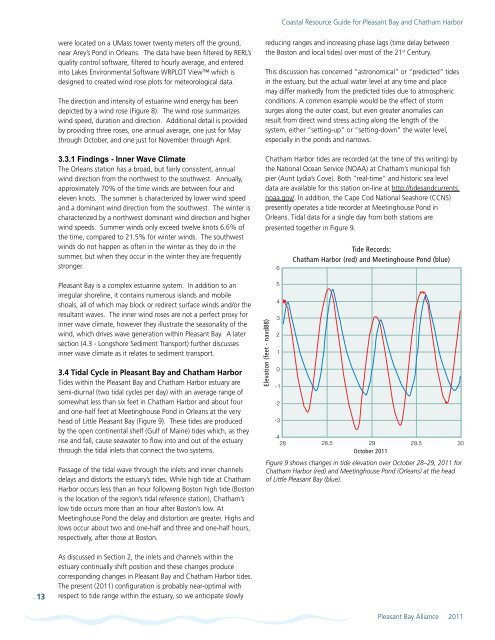Coastal Resource Guide Pleasant Bay and ... - Town to Chatham
Coastal Resource Guide Pleasant Bay and ... - Town to Chatham
Coastal Resource Guide Pleasant Bay and ... - Town to Chatham
You also want an ePaper? Increase the reach of your titles
YUMPU automatically turns print PDFs into web optimized ePapers that Google loves.
<strong>Coastal</strong> <strong>Resource</strong> <strong>Guide</strong> for <strong>Pleasant</strong> <strong>Bay</strong> <strong>and</strong> <strong>Chatham</strong> Harborwere located on a UMass <strong>to</strong>wer twenty meters off the ground,near Arey’s Pond in Orleans. The data have been filtered by RERL’squality control software, filtered <strong>to</strong> hourly average, <strong>and</strong> enteredin<strong>to</strong> Lakes Environmental Software WRPLOT View which isdesigned <strong>to</strong> created wind rose plots for meteorological data.The direction <strong>and</strong> intensity of estuarine wind energy has beendepicted by a wind rose (Figure 8). The wind rose summarizeswind speed, duration <strong>and</strong> direction. Additional detail is providedby providing three roses, one annual average, one just for Maythrough Oc<strong>to</strong>ber, <strong>and</strong> one just for November through April.3.3.1 Findings - Inner Wave ClimateThe Orleans station has a broad, but fairly consistent, annualwind direction from the northwest <strong>to</strong> the southwest. Annually,approximately 70% of the time winds are between four <strong>and</strong>eleven knots. The summer is characterized by lower wind speed<strong>and</strong> a dominant wind direction from the southwest. The winter ischaracterized by a northwest dominant wind direction <strong>and</strong> higherwind speeds. Summer winds only exceed twelve knots 6.6% ofthe time, compared <strong>to</strong> 21.5% for winter winds. The southwestwinds do not happen as often in the winter as they do in thesummer, but when they occur in the winter they are frequentlystronger.<strong>Pleasant</strong> <strong>Bay</strong> is a complex estuarine system. In addition <strong>to</strong> anirregular shoreline, it contains numerous isl<strong>and</strong>s <strong>and</strong> mobileshoals, all of which may block or redirect surface winds <strong>and</strong>/or theresultant waves. The inner wind roses are not a perfect proxy forinner wave climate, however they illustrate the seasonality of thewind, which drives wave generation within <strong>Pleasant</strong> <strong>Bay</strong>. A latersection (4.3 - Longshore Sediment Transport) further discussesinner wave climate as it relates <strong>to</strong> sediment transport.3.4 Tidal Cycle in <strong>Pleasant</strong> <strong>Bay</strong> <strong>and</strong> <strong>Chatham</strong> HarborTides within the <strong>Pleasant</strong> <strong>Bay</strong> <strong>and</strong> <strong>Chatham</strong> Harbor estuary aresemi-diurnal (two tidal cycles per day) with an average range ofsomewhat less than six feet in <strong>Chatham</strong> Harbor <strong>and</strong> about four<strong>and</strong> one-half feet at Meetinghouse Pond in Orleans at the veryhead of Little <strong>Pleasant</strong> <strong>Bay</strong> (Figure 9). These tides are producedby the open continental shelf (Gulf of Maine) tides which, as theyrise <strong>and</strong> fall, cause seawater <strong>to</strong> flow in<strong>to</strong> <strong>and</strong> out of the estuarythrough the tidal inlets that connect the two systems.Passage of the tidal wave through the inlets <strong>and</strong> inner channelsdelays <strong>and</strong> dis<strong>to</strong>rts the estuary’s tides. While high tide at <strong>Chatham</strong>Harbor occurs less than an hour following Bos<strong>to</strong>n high tide (Bos<strong>to</strong>nis the location of the region’s tidal reference station), <strong>Chatham</strong>’slow tide occurs more than an hour after Bos<strong>to</strong>n’s low. AtMeetinghouse Pond the delay <strong>and</strong> dis<strong>to</strong>rtion are greater. Highs <strong>and</strong>lows occur about two <strong>and</strong> one-half <strong>and</strong> three <strong>and</strong> one-half hours,respectively, after those at Bos<strong>to</strong>n.reducing ranges <strong>and</strong> increasing phase lags (time delay betweenthe Bos<strong>to</strong>n <strong>and</strong> local tides) over most of the 21 st Century.This discussion has concerned “astronomical” or “predicted” tidesin the estuary, but the actual water level at any time <strong>and</strong> placemay differ markedly from the predicted tides due <strong>to</strong> atmosphericconditions. A common example would be the effect of s<strong>to</strong>rmsurges along the outer coast, but even greater anomalies canresult from direct wind stress acting along the length of thesystem, either “setting-up” or “setting-down” the water level,especially in the ponds <strong>and</strong> narrows.<strong>Chatham</strong> Harbor tides are recorded (at the time of this writing) bythe National Ocean Service (NOAA) at <strong>Chatham</strong>’s municipal fishpier (Aunt Lydia’s Cove). Both “real-time” <strong>and</strong> his<strong>to</strong>ric sea leveldata are available for this station on-line at http://tides<strong>and</strong>currents.noaa.gov/. In addition, the Cape Cod National Seashore (CCNS)presently operates a tide recorder at Meetinghouse Pond inOrleans. Tidal data for a single day from both stations arepresented <strong>to</strong>gether in Figure 9.Elevation (feet - navd88)6543210-1-2-3-428Tide Records:<strong>Chatham</strong> Harbor (red) <strong>and</strong> Meetinghouse Pond (blue)28.5 29 29.5 30Oc<strong>to</strong>ber 2011Figure 9 shows changes in tide elevation over Oc<strong>to</strong>ber 28–29, 2011 for<strong>Chatham</strong> Harbor (red) <strong>and</strong> Meetinghouse Pond (Orleans) at the headof Little <strong>Pleasant</strong> <strong>Bay</strong> (blue).13As discussed in Section 2, the inlets <strong>and</strong> channels within theestuary continually shift position <strong>and</strong> these changes producecorresponding changes in <strong>Pleasant</strong> <strong>Bay</strong> <strong>and</strong> <strong>Chatham</strong> Harbor tides.The present (2011) configuration is probably near-optimal withrespect <strong>to</strong> tide range within the estuary, so we anticipate slowly<strong>Pleasant</strong> <strong>Bay</strong> Alliance 2011
















